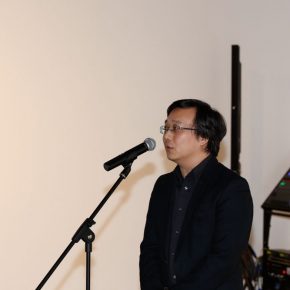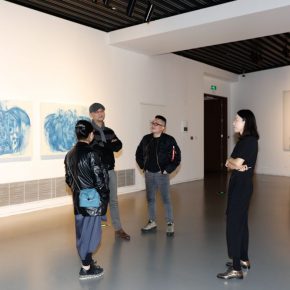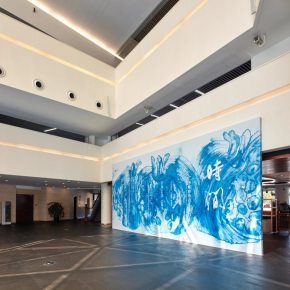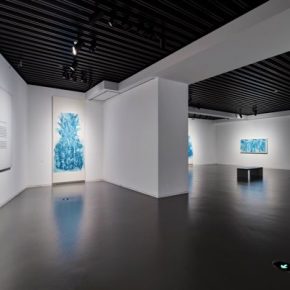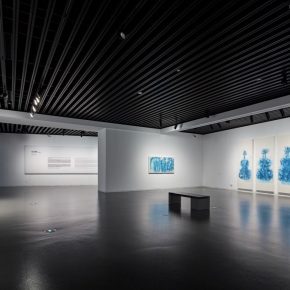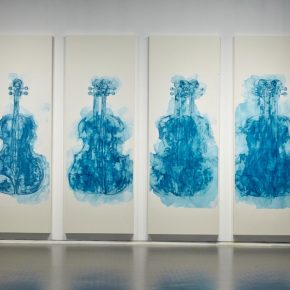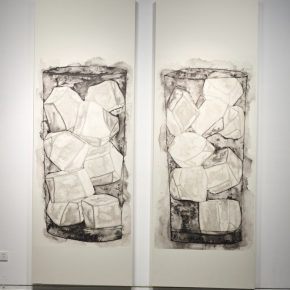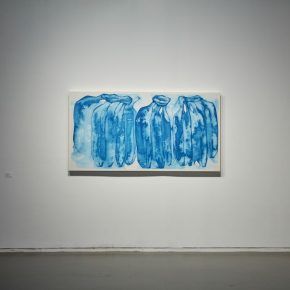
On March 4, 2018, “Times – New Works by Li Tingting” opened in Shanghai Liu Haisu Art Museum. It is jointly hosted by Moudao Culture and Dachuan Culture, and Shen Kuiyi, Professor of Art History, Theory and Criticism from the Department of Visual Arts, San Diego, the University of California, serves as the curator. It is organized by Liu Haisu Art Museum, co-organized by the Cross-Media Studio of the College of Arts at Renmin University of China, specially supported by Gugen Culture and displays more than 20 pieces recently created by Li Tingting. The exhibition remains on view till March 7.
The theme of the exhibition “Times” is inspired by a constantly superimposed “Violin” quadruplet exhibited in the exhibition. Along with this, there continues an overlap of a violin on a violin, remaining trajectories sliding on the screen, prompting a trace showing the passage of time through figures. In addition, “times” also refer to the artist Li Tingting’s practice of ink-and-wash creation which has been persisted for more than ten years. Seeing it from a visual perspective, we find the “Times” of Li Tingting’s painting is also a connection between the language & value of traditional ink and wash paintings and contemporary aesthetic reality and it is a new possibility that appears in the process of the development of the language of ink. Seeing it from the perspective of pictorial objects, the ordinary fruit, vegetables and everyday utensils in the paintings, instantly remind the audience of the traditional Western still life, which is also the most common theme to perform time in Western paintings. The exhibition contains cultural meanings with oriental characteristics and has a strong readability in the portraying of the Chinese literati on fruits and vegetables. Li Tingting’s paintings are based on the theme of fruits, vegetables and utensils, which are neither a continuation of the logic of Chinese traditional painting nor an expansion of the Western model in contemporary China. When I have finished the works by Li Tingting in seeing the time behind an artist, the exhibition shows the state of the artist, the state and mind associated with her paintings.
As a young artist born in the 1980s, Li Tingting has also some unique characteristics for this generation, such as a sedentary lifestyle. Li Tingting self-proclaimed that she was a sedentary woman during her life, and she also focused on the trivial and fragments of daily life. She often stares at a cup on the table for a long time, and really enjoys the experience. In her opinion, it is insignificant but reveals human breath and through this breath she turns the small thing to a brilliant thing. Li Tingting takes daily life as her artistic creation, which makes her works delicate and soft, revealing her random and free attitude to life. This randomness is also reflected in her attitude toward the changes in creative environments. She moved to the south of China from the north of China, the moist weather of the south seriously affects the status of the paper and the mastery of the time of painting, but she reconciles herself to the situation and paints in a more leisurely fashion, after settling in the south.
I feel that I have entered a visual blue ocean when walking into Li Tingting’s exhibition space, its visual effects is a real eye-opener, and also triggers an unlimited beautiful imagination, as Ruan Jun, Deputy Director of Liu Haisu Art Museum, said that it was an exhibition of ink painting that was absolutely different from the traditional feeling. It is an exhibition of spring. The choice of color was inspired by a handy visual game in the artist’s life. When she once arranged a variety of colors, she occasionally found the monochromatic blues perfectly fitted her mood and her expected visual perception. Li Tingting said that her creation has always been a visual game, and the attitude of “game” is mainly reflected in the many landscapes that are on display. These landscapes have the traditional patterns of delineating and dyeing, but they have greatly subverted the space of the painting, as the curator Shen Kuiyi in her review stated, “it attempts to deconstruct the screen in order to subvert the traditional two-dimensional presentation and viewing style of landscapes.” Chinese landscapes have always created a three-way artistic conception, while Li Tingting’s landscapes break the traditional model, the use of the screen and frame to form a relationship of ablation or breakthrough, forming a new spatial relationship. It has also challenged the traditional viewing concept of landscapes, and she even drew landscapes at the back of a piece, to form a 360-degree view, so that we can also say that it eliminates the boundaries between both sides using this system. In some landscapes, a screen is inserted into another piece, to form an illusion and the two have also visually formed a fragmented effect and increased brilliance with mutual reflection. In this series of works, the screen has a clear distinction of color shades. Li Tingting also introduced that it contained a visual game in the exhibition hall, and a line of demarcation of color shades that have been specially arranged in a horizontal line, while this harmony may not be easily seen by the audience because of the distance between paintings.
Li Tingting’s painting is free and casual, and is reflected in the attention she has paid to all things in her daily life, being free to draw the blue that suits her screen and her free deconstruction and reconstruction of landscapes. Perhaps it is related to the education she has received.
When she was studying at the College of Arts at Renmin University of China, her teacher Professor Huang Huasan asked her to ask herself “What are you going to do” instead of “you should do what I tell you”. But at the same time, Li Tingting is also devout and pure in painting. She has always had her own set of recognized things and is insistant in her field. She believes she will certainly succeed in five or ten years. Perhaps the “times” of Li Tingting’s paintings can be regarded as purely insistent and free game playing.
Text by Zhang Wenzhi, translated by Chen Peihua and edited by Sue/CAFA ART INFO
Photo by the organizer?


